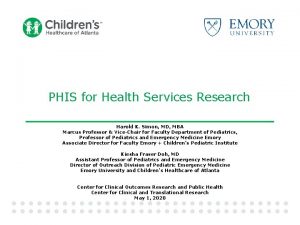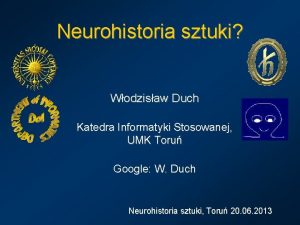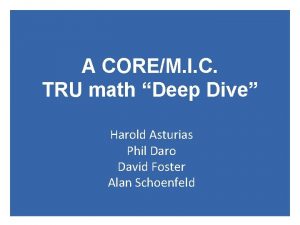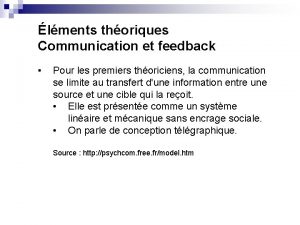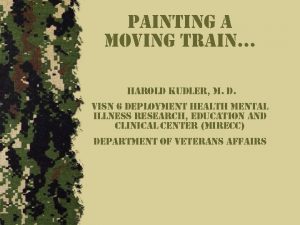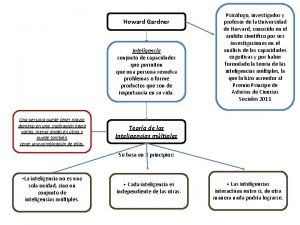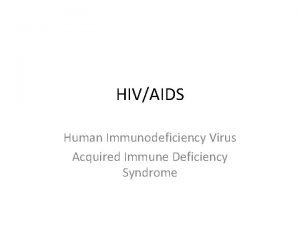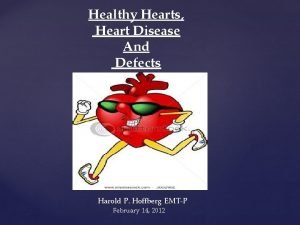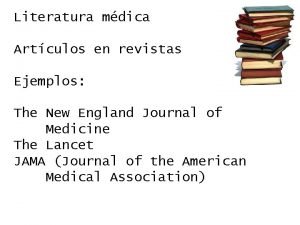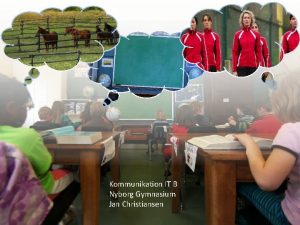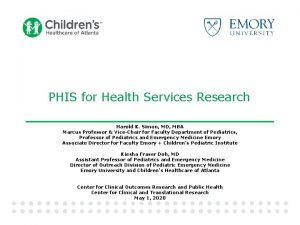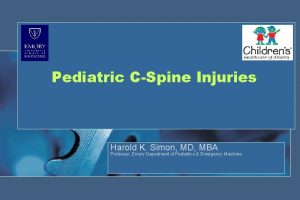PHIS for Health Services Research Harold K Simon











































- Slides: 43

PHIS for Health Services Research Harold K. Simon, MD, MBA Marcus Professor & Vice-Chair for Faculty Department of Pediatrics, Professor of Pediatrics and Emergency Medicine Emory Associate Director for Faculty Emory + Children’s Pediatric Institute Kiesha Fraser Doh, MD Assistant Professor of Pediatrics and Emergency Medicine Director of Outreach Division of Pediatric Emergency Medicine Emory University and Children’s Healthcare of Atlanta Center for Clinical Outcomes Research and Public Health Center for Clinical and Translational Research May 1, 2020

Acknowledgements • Thank you to Matt Hall, Ph. D, Principal Biostatistician for Children’s Hospital Association (CHA) who shared much of the substance and context for this presentation. • To note, while involved for several years with CHA and PHIS related research I have no financial interests of conflicts related to this presentation

Overview for today • What is PHIS & its sources • Strengths & limitations • Examples of PHIS related research • Research resources

4 What is PHIS • Pediatric Health Information System (PHIS) • Administrative data is collected primarily for billing purposes, but is sent to multiple stakeholders for various reasons (e. g. quality, benchmarking) • Buy-in and evolution to a research resource • Research initiatives (began 2006) – 10 invited physicians to perform collaborative research with PHIS – First publication 2007 Off-Label Drug Use in Hospitalized Children (2007) Archives of Pediatrics & Adolescent Medicine – Through 2019, >800 publications, 200+journals

5 Output Successes • 800+ publications • 200+ journals Top Journals Pediatrics The Journal of Pediatrics Journal of Pediatric Surgery Pediatric Blood & Cancer JAMA Pediatrics Pediatric Critical Care Medicine Hospital Pediatrics Pediatric Cardiology Journal of Hospital Medicine N Articles 99 49 40 28 25 24 24 22 21

6 PHIS Data Arrival Registrar enters demographics into record During the Encounter Clinicians Resources document administered Dx and Pr captured in in the chart billing record Discharge Coding dept “translates” documentation to CPT/ICD-10 6

8 What data are in PHIS? PHIS By The Numbers INPATIENT AMBULATORY SURGERY EMERGENCY DEPT. OBSERVATION STATUS (Since 2004) • • • Participating Hospitals: 52 Inpatient Cases: 7. 4 million Inpatient Days: 46. 0 million ED encounters: 32. 4 million Total Charges: $534 billion Total ICD-9/10 Codes: 188. 4 million Key features. . . Patients can be tracked across encounters Hospitals have direct access Hospitals are un-blinded Medical Record System Billing System PHIS

PHIS participating hospitals Akron – Akron Children’s Hospital Ann Arbor – C. S. Mott Children’s Hospital **Atlanta - Children’s Healthcare of Atlanta Austin – Dell Children’s Medical Center of Central Texas Birmingham - Children’s of Alabama Boston – Boston Children’s Hospital Charleston – MUSC Children’s Hospital Chicago – Lurie Children’s Hospital of Chicago – Comer Children’s Hospital Chicago – Advocate Children’s Hospital Cincinnati - Children’s Hospital Medical Center Cleveland – UH Rainbow Babies & Children’s Hospital Columbus – Nationwide Children’s Hospital Corpus Christi - Driscoll Children’s Hospital Dallas - Children’s Health Children’s Medical Center of Dallas Denver - Children’s Hospital Colorado Fresno / Madera – Valley Children’s Hospital Ft. Worth - Cook Children’s Medical Center Hartford - Connecticut Children’s Medical Center Houston - Texas Children’s Hospital Houston – Children’s Memorial Hermann Hospital Indianapolis - Riley Hospital for Children at Indiana University Health Kansas City - Children’s Mercy Hospitals & Clinics Knoxville - East Tennessee Children’s Hospital Little Rock - Arkansas Children’s Hospital Long Beach – Miller Children’s and Women’s Hospital Long Beach Los Angeles - Children’s Hospital Los Angeles Louisville – Norton Children’s Hospital Memphis - Le Bonheur Children’s Medical Center Miami – Nicklaus Children’s Hospital Milwaukee - Children’s Hospital of Wisconsin Minneapolis – Children’s Minnesota Nashville - Vanderbilt Children’s Hospital New Haven – Yale-New Haven Children’s Hospital New York - New York Presbyterian-Morgan Stanley Children’s Hosl Norfolk - Children’s Hospital of The King’s Daughters Oakland - UCSF Benioff Children’s Hospital Oakland Omaha - Children’s Hospital and Medical Center Orange - Children’s Hospital of Orange County Palo Alto - Lucile Packard Children’s Hospital Stanford Philadelphia - The Children’s Hospital of Philadelphia Phoenix - Phoenix Children’s Hospital Pittsburgh - Children’s Hospital of Pittsburgh of UPMC Salt Lake City - Primary Children’s Hospital San Diego – Rady Children’s Hospital San Diego Seattle – Seattle Children’s Hospital St. Petersburg – Johns Hopkins All Children’s Hospital St. Louis - St. Louis Children’s Hospital Washington D. C. - Children’s National Health System **NOTE: CHOA reports from all 3 campuses. Reports pooled data but can be separated by campus

Current CHA Structure for Collabor Research 10

Current research nodes and working groups through CHA Infectious diseases Emergency Department Hospital Medicine Intensive Care Complex care Mental health Quality Surgery Social determinants of health Policy Special Interest Groups • Pneumonia • Readmissions • Asthma 11 Data also available through local access at all contributing institutions

What’s collected on each encounter? Billed Transaction/ Utilization Data Patient Abstract and ICD Coding (all items/services billed to the patient) Patient Abstract Diagnoses (ICD-9/10) Procedure (ICD-9/10) PATIENT ENCOUNTER Pharmacy Imaging / Radiology Lab Clinical Other Supplies CPT Codes Hospital ID Patient ID Dates/LOS Age, Bw, Gest Age Principal Diagnosis Principal Procedure Disposition APR-DRG MS-DRG Key Physicians Payer - Room/Nursing - Surgical Svcs - Other Misc.

Patient abstract Diagnoses (ICD-9/10) • • • Up to 41 dxs, assigned at discharge Present on admission indicator Not date stamped Procedures (ICD-9/10) • • • Up to 41 prs, assigned at discharge Not just surgical Date stamped

Billing data in PHIS Hospital A 35309888 Vancomycin 125 mg Hospital B 6561447 CTC Code 124133. 1011552 12 Anti-infectives (Drug Class = 12) 124 Misc antibiotics (Therapeutic Cat = 124) 124133 Vancomycin (Generic Drug=124133) 12413310 oral (Route of Administration=10) 1241331011 tablet (Dosage Form=11) 124133101155 55 (Strength=125) 1241331011552 mg (Unit of Measure=2) Tablet 125 mg Vancomycin

PHIS pharmacy data Pharmacy Value: § Compare drug utilization § Compare when drugs were given (by day) § Compare route of administration

Strengths and Limitations for Research Strengths of administrative data in research • Patient level data • Line item utilization • Population size = Power • Multiple institutions for rare conditions • Hospital-to-hospital variation

Strengths and Limitations for Research Limitations of administrative data in research • Retrospective and observational • Significant risk adjustment factors might be missing • Potentially link to registries • Outcomes are limited • Unknown Sen/Spec for many ICD-9/10 codes; dxs and pxs rely on proper documentation and coding • ICD codes in administrative databases generally have high specificity (e. g. , few instances in which patients did not in fact receive a diagnosis of the condition) but may have lower sensitivity (i. e. , the administrative diagnosis may fail to detect all true cases) - Zaoutis, Pediatrics, 2006 • Charges are billed resource, not necessarily administered

1 8 Overcoming limitations with linkages Registries Case ascertainment Risk adjustment Outcomes PHIS Cost Utilization Long term outcomes • • • PHIS linkages to date: Vermont Oxford Network (NICU) Children’s Hospitals Neonatal Database (NICU) Society of Thoracic Surgeons (Cardiac Surgery) Virtual PICU System (PICU) Children’s Oncology Group (Oncology) Center for International Blood and Marrow Transplant Research (BMT) Pediatric Heart Network (Cardiac Surgery) United Network for Organ Sharing (Transplant) Scientific Registry of Transplant Recipients (Transplant) Cystic Fibrosis Foundation (CF) National Surgical Quality Improvement Program (Gen Surgery) • Also, studies have combined hospital level surveys for hospital factor characteristic linkages

Types of Research Using PHIS 19

Prioritization Quantifying the Burden of Interhospital Cost Variation in Pediatric Surgery: Implications for the Prioritization of Comparative Effectiveness Research. Cameron DB 1, Graham DA 2, Milliren CE 2, Glass CC 1, Feng C 1, Sidhwa F 1, Thangarajah H 3, Hall M 4, Rangel SJ 1. JAMA Pediatr. 2017 Feb 6; 171(2): e 163926. doi: 10. 1001/jamapediatrics. 2016. 3926. Epub 2017 Feb 6. • • 44 hospitals 30 most common pediatric surgical conditions N=95, 353 Cost variation quantified after adjusting for differences in patient-level case-mix and hospitallevel accounting methods

Prioritization Cost variation/case Framework: Define opportunities where variation between hospitals is great and relative cost-variation is high Lower priority procedures (high cost variation/case, but low-cost variation burden) High-priority procedures (high cost variation & high cost variation burden) Lowest priority procedures (low-cost variation/case & Low-cost variation burden) Lower priority procedures (high cost variation burden, but low-cost variation/case)

Prioritization

Epidemiology / Population Estimates • PHIS is a non-population based database • Population estimates difficult, but some sub-populations • Epidemiology of quaternary diagnoses or procedures Epidemiology within children’s hospitals • Potential research topics… • What is the prevalence of a disease in the population? • How frequently is a procedure done in a population? • How often is a co-morbidity present among hospitalized 23 children with a specific diagnosis?

Epidemiology / Population Estimates The Care of Adult Patients in Pediatric EDs. Samuels-Kalow M, Neuman MI, Rodean J, Marin J, Aronson PL, Hall M, Freedman SB, Morse RB, Cohen E, Simon HK, Shah SS, Berry JG, Alpern ER. PMID: 30853574 Academic Pediatrics Nov – Dec 2019; 19(8): 942 -947.

Drivers of cost • Most administrative data sources capture charges, not costs • Costs are estimated using cost-to-charge ratios (hospital-level or department specific) • Potential research topics… • • Public vs. private expenditures Incremental costs associated with comorbidities Compare costs of treating with drug x versus drug y Identify factors associated with increased cost

Drivers of Cost Pediatric Severe Sepsis: Current Trends and Outcomes from the Pediatric Health Information Systems Database Ruth A, Mc. Cracken CE, Fortenberry JD, Hall M, Simon HK. Hebbar KB. Pediatric Severe Sepsis: Database. Pediatr Critical Care Medicine PMID: 25226500 Nov. 2014; 15(9): 828 -38.

Drivers of Cost

Longitudinal Data Analysis • PHIS can track patients across encounters within the same hospital • Potential research topics… • Readmissions • Time-to-event analysis • Trends in admissions or seasonality 28

Longitudinal Data Analysis

Longitudinal Data Analysis Delayed Diagnoses in Children with Constipation: Multicenter Retrospective Cohort Study. Freedman SB, Rodean J, Hall M, Alpern ER, Aronson PL, Simon HK, Shah SS, Marin JR, Cohen E, Morse RB, Katsogridakis Y, Berry JG 1, Neuman MI 1. J Pediatr. 2017 Jul; 186: 87 -94. e 16. doi: 10. 1016/j. jpeds. 2017. 03. 061. Epub 2017 Apr 28.

Utilization Variation • Look for frequency of utilization (drugs, imaging, labs, etc. ) in a population • Variation in patient care within/across hospitals • Potential research topics… • Disparities in care • Adherence to evidence-based guidelines • Evaluate the effect of clinical care guidelines (pre vs. post) • Impact of case volume on outcomes 31

Utilization Variation Hospital-level compliance with asthma care quality measures at children's hospitals and subsequent asthma-related outcomes. Morse RB, Hall M, Fieldston ES, Mc. Gwire G, Anspacher M, Sills MR, Williams K, Oyemwense N, Mann KJ, Simon HK, Shah SS. JAMA. 2011 Oct 5; 306(13): 1454 -60. doi: 10. 1001/jama. 2011. 1385. PMID: 21972307

Comparative Effectiveness Low-Value Diagnostic Imaging Use in the Pediatric Emergency Department in the United States and Canada. Cohen E, Rodean J, Diong C, Hall M, Freedman SB, Aronson PL, Simon HK, Marin JR, Samuels-Kalow M, Alpern ER, Morse RB, Shah SS, Peltz A, Neuman MI. JAMA Pediatr. 2019 3; 173(8): e 191439. PMID: 31157877 Note: Here we used PHIS versus Canadian database • • • Objective: To compare overall and low-value use of diagnostic imaging across pediatric ED visits in Ontario, Canada, and the United States. Design, setting, and participants: This study used administrative health databases from 4 pediatric EDs in Ontario and 26 in the United States in calendar years 2006 through 2016. Individuals 18 years and younger who were discharged from the ED, including after visits for diagnoses in which imaging is not routinely recommended (eg, asthma, bronchiolitis, abdominal pain, constipation, concussion, febrile convulsion, seizure, and headache) were included. Data analysis occurred from April 2018 to October 2018. Main outcome and measures: Overall and condition-specific low-value imaging use. Three-day and 7 -day rates of hospital admission and those admissions resulting in intensive care, surgery, or in-hospital mortality were assessed as balancing measures. Results: A total of 1 783 752 visits in Ontario and 21 807 332 visits in the United States were analyzed. Compared with visits in the United States, those in Canada had lower overall use of head computed tomography (Canada, 22 942 [1. 3%] vs the United States, 753 270 [3. 5%]; P <. 001), abdomen computed tomography (5626 [0. 3%] vs 211 018 [1. 0%]; P <. 001), chest radiographic imaging (208 843 [11. 7%] vs 3 408 540 [15. 6%]; P <. 001), and abdominal radiographic imaging (77 147 [4. 3%] vs 3 607 141 [16. 5%]; P <. 001). Low-value imaging use was lower in Canada than the United States for multiple indications, including abdominal radiographic images for constipation (absolute difference, 23. 7% [95% CI, 23. 2%24. 3%]) and abdominal pain (20. 6% [95% CI, 20. 3%-21. 0%]) and head computed tomographic scans for concussion (22. 9% [95% CI, 22. 3%23. 4%]). Abdominal computed tomographic use for constipation and abdominal pain, although low overall, were approximately 10 -fold higher in the United States (0. 1% [95% CI, 0. 1%-0. 2%] vs 1. 2% [95% CI, 1. 2%-1. 2%]) and abdominal pain (0. 8% [95% CI, 0. 7%-0. 9%] vs 7. 0% [95% CI, 6. 9%7. 1%]). Rates of 3 -day and 7 -day post-ED adverse outcomes were similar. Conclusions and relevance: Low-value imaging rates were lower in pediatric EDs in Ontario compared with the United States, particularly those involving ionizing radiation. Lower use of imaging in Canada was not associated with higher rates of adverse outcomes, suggesting that usage may be safely reduced in the United States.

3 4 PHIS Training Options There are two types of training (depending on need) to access PHIS. Both are free with CHCA participation, the first is much more involved. a) To be a PHIS reporter (i. e. write reports against PHIS) using Business Objects, there is an online summer course upcoming. Contact for more info: Analytics. Support@childrenshospitals. org and reference PHIS REPORTER ACCESS b) To simply extract raw data from PHIS to be analyzed elsewhere (this is most common for researchers), you need training for using the Cohort Builder. There is a series of 4 -5 online on-demand videos to watch. Contact for more info: Analytics. Support@childrenshospitals. org and reference COHORT BUILDER ACCESS

3 5 Individuals with Local reporter PHIS Access • Primary Contact – Robert Palmer Ph. D Director, Outcomes and Quality Measurement (Robert. Palmer@choa. org) • Local Children’s PHIS Reporters recognized by CHA • • • • • Adams, Destinee Data Management Coordinator Braykov, Nikolay BI Quantitative Analyst Cash, Lisa Quality Analysis Data Engineer Edmond, Mary Manager of Analysis and Transformation Giannopoulos, Helen Clinical Pharmacy Manager, Egleston Campus Hua, Hannah BI Quantitative Analyst Mc. Carter, Andrea BI Quantitative Analyst Mc. Rae, William Outcomes Analyst Palmer, Robert Director, Outcomes and Quality Measurement Plant, Juanita Government Profiling Specialist Rocks, Greg Business Analyst Sterner-Allison, Jennifer Pharmacy Clinical Manager Sullivan, Dennis Quality Analysis Data Engineer Sumrall, Nathan Medical Economist Tejedor-Sojo, Javier Medical Director Outcomes and Population Health Wong, Emily BI Quantitative Analyst Others? ? ?

3 6 Joining Potential National Research Groups • Getting involved in a PHIS research group: Contact: Research@childrenshospitals. org – (Matt and a few others monitor this site) – Alternatively Matt. Hall@childrenhospitals. org

Utilizing CHA-PHIS Database from Research Idea to Publication-First Phase

Utilizing CHA-PHIS Database from Research Idea to Publication-First Phase

Utilizing CHA-PHIS Database from Research Idea to Publication. Second Phase

Utilizing CHA-PHIS Database from Research Idea to Publication. Third Phase

Utilizing CHA-PHIS Database from Research Idea to Publication. Success Phase-Data

childrenshospitals. org/researchacademy Children’s Hospital Association 600 13 th St. , NW | Suite 500 | Washington, DC 20005 | 202 -753 -5500 16011 College Blvd. | Suite 250 | Lenexa, KS 66219 | 913 -262 -1436 www. childrenshospitals. org 42

4 3 CHA Health Services Research Academy This teaches the fundamentals of doing HSR with any database. It is a pay to participate program, and participation is tiered based on the individual’s needs. 3 Tiers (about 27 participants this year) Run by Matt Hall – 1) 25 online HSR modules • About ½ hr each (~2 k) – 2) Modules • plus 1 consult/mo (~6 k) – 3) Modules • plus 2 consults/mo • ongoing stats project support (~12 K)

4 4 PHIS for Health Services Research • ? ? ?
 Cha phis
Cha phis Thibaut kelley
Thibaut kelley Harold hütt herrera
Harold hütt herrera Harold cohen aaron
Harold cohen aaron Sir harold mac micheal
Sir harold mac micheal Klasifikasi negara menurut h.n sinha
Klasifikasi negara menurut h.n sinha Godfrey harold hardy
Godfrey harold hardy Minecraft harold brian
Minecraft harold brian Harold pincus
Harold pincus When did macmillan resign
When did macmillan resign Harold castilla devoz
Harold castilla devoz El reloj de acaz
El reloj de acaz Harold hill nasa
Harold hill nasa Edwin binney and harold smith
Edwin binney and harold smith Tru math framework
Tru math framework Hark the harold
Hark the harold Harold demsetz toward a theory of property rights
Harold demsetz toward a theory of property rights Harold arlen somewhere over the rainbow
Harold arlen somewhere over the rainbow Modèle de jakobson communication
Modèle de jakobson communication Kommunikationsmodeller
Kommunikationsmodeller J ernest wilkins jr biography
J ernest wilkins jr biography Harold jacobs geometry
Harold jacobs geometry When did harold godwinson become king
When did harold godwinson become king Hodocasce cajlda harolda
Hodocasce cajlda harolda Harold kudler
Harold kudler Harold grossman
Harold grossman Burt selden flowers for algernon
Burt selden flowers for algernon Latar belakang munculnya aliran sisi penawaran
Latar belakang munculnya aliran sisi penawaran Harold koontz management theory
Harold koontz management theory Harold hill nasa
Harold hill nasa Harold gardner pianiste
Harold gardner pianiste Harold jaffe cdc
Harold jaffe cdc Harold heart attack
Harold heart attack Medya okuryazarlığı modelleri
Medya okuryazarlığı modelleri Harold tennekes
Harold tennekes What is the highest level of human need according to maslow
What is the highest level of human need according to maslow Gnumed
Gnumed Kanyle-modellen
Kanyle-modellen Sarah harold
Sarah harold Harold wiesenfeld
Harold wiesenfeld Harold schogger
Harold schogger Teori asal usul kehidupan disusun berdasarkan ....
Teori asal usul kehidupan disusun berdasarkan .... Harold liu
Harold liu Harold and the purple crayon summary
Harold and the purple crayon summary
